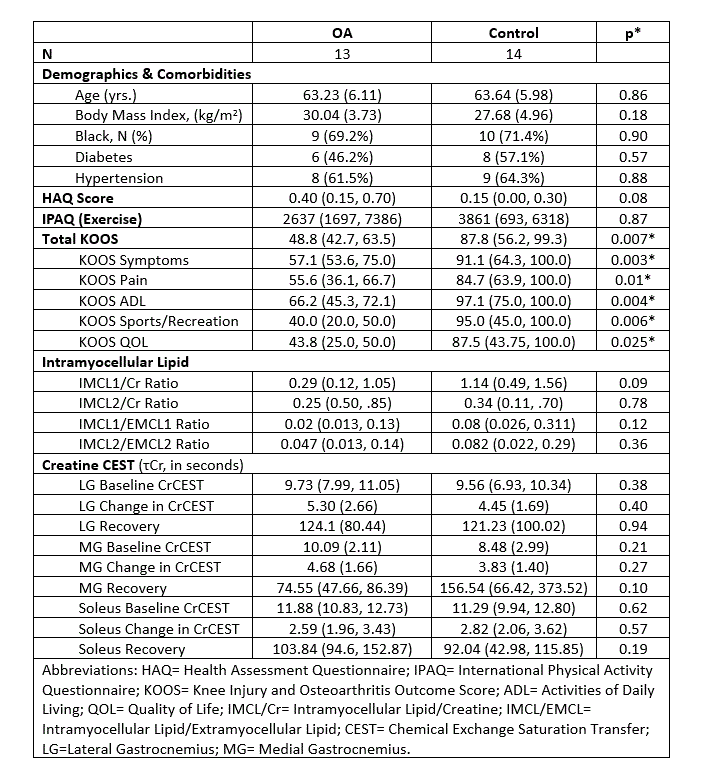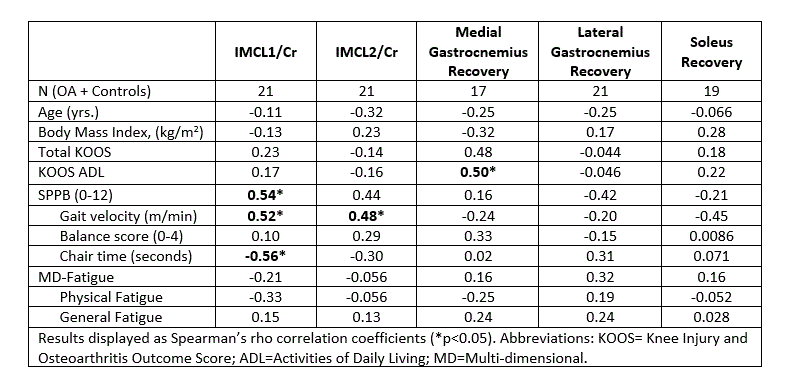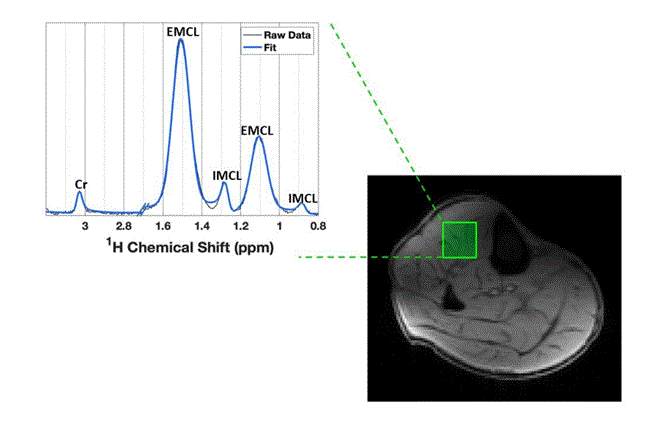Session Information
Date: Monday, November 18, 2024
Title: Muscle Biology, Myositis & Myopathies – Basic & Clinical Science Poster III
Session Type: Poster Session C
Session Time: 10:30AM-12:30PM
Background/Purpose: Intramyocellular lipids (IMCL), stored within lipid droplets in skeletal muscle cells, serve as an important metabolic fuel source during exercise. Endurance athletes have demonstrated higher IMCL levels, indicating a relationship between IMCL and muscle energy demands.1 In order to assess muscle metabolic health, this study aimed to evaluate IMCL levels and mitochondrial activity in patients with knee osteoarthritis (KOA) and the association of each with muscle function. No prior studies, to our knowledge, have evaluated both IMCL and mitochondrial energetics in the skeletal muscle of patients with KOA.
Methods: Male veterans with KOA (age 18-80 years, BMI < 35 kg/m2), were matched on age to healthy controls. Proton magnetic resonance spectroscopy (1H-MRS) was used to measure the ratio of IMCL-to-creatine (Cr) using a point resolved echo spectroscopy sequence with the following scan parameters: TE=280ms, TR=2s, Averages=144, and Acquisition Time=5m04s. The voxel (size 20x20x20mm3) was placed in the tibialis anterior. Cr, IMCL, and extramyocellular lipid values were quantified by fitting the spectrum with 4 Lorentzian peaks (Figure 1) using an in-house Matlab script. Mitochondrial activity was assessed using Cr chemical exchange saturation transfer (CEST). Images were acquired at 7T to measure free creatine. The rate of creatine recovery, a measure related to energy efficiency production in the muscle, was assessed for three muscle groups after participants completed plantar flexion exercises. Additional data on symptoms, patient-reported outcomes, and physical performance were collected. Group differences between OA and controls were described, and correlations between IMCL, CrCEST, and patient characteristics were evaluated.
Results: A total of 27 patients were included. The mean (SD) age and BMI of study participants were 63.4 (5.9) years and 28.8 (4.5) kg/m2, respectively. OA participants exhibited lower Knee Injury and Osteoarthritis Outcome Score (KOOS) compared to controls overall (p=0.007) and across all KOOS sub-scales (Table 1). There were no differences in self-reported exercise. IMCL levels tended to be lower in patients with OA, though this was not statistically significant. There were no significant differences in measures of mitochondrial function between OA patients and controls in any of the muscle groups. Higher IMCL levels were associated with greater Short Physical Performance Battery (SPPB) (rho=0.54, p=0.017), increased gait velocity (rho=0.52, p=0.029), and faster chair stand time (rho= -0.56, 0.016), suggesting better physical function among those with higher IMCL (Table 2). There was no significant association between mitochondrial activity and physical function.
Conclusion: This study suggests that people with KOA may have depletion of IMCL in association with poor physical functioning. The association between lower IMCL and poor physical function may be related to the depletion of a key fuel source for active muscle. Though large-scale use of 1H-MRS and CrCEST techniques is limited by cost and technical challenges, larger studies are needed to understand muscle metabolism in patients with KOA.
References:
1. Seibert, JT, et al. (2020); PMID: 32917515
To cite this abstract in AMA style:
Gillcrist R, Olave M, Armbruster R, Baker J. Associations Between Intramyocellular Lipid and Muscle Function in Patients with Osteoarthritis [abstract]. Arthritis Rheumatol. 2024; 76 (suppl 9). https://acrabstracts.org/abstract/associations-between-intramyocellular-lipid-and-muscle-function-in-patients-with-osteoarthritis/. Accessed .« Back to ACR Convergence 2024
ACR Meeting Abstracts - https://acrabstracts.org/abstract/associations-between-intramyocellular-lipid-and-muscle-function-in-patients-with-osteoarthritis/



